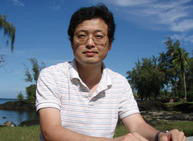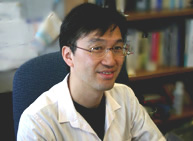Topics
Subaru Staff -Part 19-
July 28, 2008
| We continue the AO (Adaptive Optics) development group interview and introduce Shin Oya, Masayuki Hattori, Yoshihiko Saito and Meguru Ito this time. They all have experiences of developing instruments and system before, so thier work contributes to the future performance of the Subaru Telescope (current as of date). |

Senior AO Scientist
Shin Oya
- Could you describe your job?
I am in charge of adaptive optics development and laser guide star system. I mostly designed the deformable mirror. For further performance improvement, I am engaged with the development of measuring methods to study more details about the property of the deformable mirror. Also, I inspect the methods for the coordination of the optical system leads star light into the deformable mirror and controls approach of the optics.
- How did you start working at Subaru Telescope?
Before I came to Subaru, I was researching the methods of obtaining a sharp image by measuring the atmospheric motions and by fixing the effect of them at NICT (National Institute of Information and Communications Technology) in Japan. My work experience is fully applied here for developing the AO instrument, and we are getting incredible results with lots of sharp images of stars. AO is currently used for near-infrared wavelengths and the study of infrared-astronomy I did at grad-school is fully maximized.
- Message to readers who wants to be an astronomer.
When you start working you will encounter unknown problems seem unsolvable at first-glance. Especially, our job as researchers has a strong effect on that perspective. Specifically, you’ve got to be the main “CPU” and learn to solve contingencies. I try to see the entire picture rather than small ones because it is not always true that the solution is only one.

AO Scientist
Masayuki Hattori
- Could you describe your job?
As an adaptive optics scientist, I develop the AO and laser guide star system for the Subaru Telescope. Specifically, my part is to obtain data from the AO system which analyzes the fluctuation of incoming wave front of light. Also, I develop software to adjust the effectiveness of the AO system automatically.
- How did you start working at Subaru Telescope?
I studied optics at the department of Applied Physics of University of Waseda, and then I researched wave front control at the NICT (National Institute of Information Communications Technology) in Japan. Since there was a strong connection between what I did and what Subaru was doing, I joined the AO development team of new AO at Subaru Telescope.
- Message to readers who wants to be an astronomer.
For those who may have a desire to become a researcher, it is important to have a fundamental knowledge in addition to wit that allows you to think differently. First, curiosity is needed, and also room in your heart and stamina to accomplish your goals, because a researchers’ job requires taking time and being patient.

AO scientist
Yoshihiko Saito
- Could you describe your job?
I am in charge of the development of the laser system in the adaptive optics and laser guide star system. My job is to do whatever it takes to maintain the quality of the laser guide star. Mainly I design and construct optical systems, and create software to control them.
- How did you start working at Subaru Telescope?
While I was in grad school, I participated in the development of the FOCAS instrument. I was not sure what equipment development was about at that time. Then I joined AO development for learning about it more and getting more involved.
- What is your inspiration?
I believe “research” opens itself to anyone; however it’s hard to conduct huge projects like Subaru Telescope’s instrument development individually. So, I find the meaning of our work in that sense. It’s not always easy to work on top of the mountain and things sometimes don’t go our way, but I believe it really depends on what you tell yourself about the situation you are in whether things are going to be enjoyable or not.

AO scientist
Meguru Ito
- Could you describe your job?
I was a graduate student at the University of Tokyo until last year, and now I research as an adaptive optics scientist at Subaru Telescope. Mainly, I examine and evaluate the performance of optical fiber which transmits high-power laser for the new adaptive optics and laser guide star system. Also, I’m in charge of development of the technology.
- How did you start working at Subaru Telescope?
I studied laser physics for my undergraduate work. One day, I found an article at a book store about the Subaru Telescope AO and laser guide star technology. From there, I got my hands on the development of laser guide star system at graduate school. I think my job maximized my experience, knowledge, and also the longing for astronomy from my youth.
- What is your inspiration?
Development of instruments is work which builds step by step and achieves its goals through cooperation with other researchers. It gives a sense of satisfaction and excitement. Working on the top of mountain, suffering by the scantiness of air, our work is sometimes harder. However, when we launched the AO laser attached to the Subaru Telescope for the first time in October 2006, I remember that I was thrilled like I have never felt before.